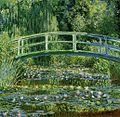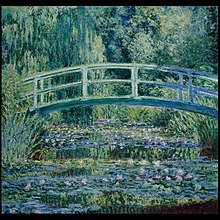Fișier:Water-Lilies-and-Japanese-Bridge-(1897-1899)-Monet.jpg

Mărimea acestei previzualizări: 617 × 599 pixeli. Alte rezoluții: 247 × 240 pixeli | 494 × 480 pixeli | 791 × 768 pixeli | 1.031 × 1.001 pixeli.
Mărește rezoluția imaginii (1.031 × 1.001 pixeli, mărime fișier: 381 KB, tip MIME: image/jpeg)
Istoricul fișierului
Apăsați pe Data și ora pentru a vedea versiunea trimisă atunci.
| Data și ora | Miniatură | Dimensiuni | Utilizator | Comentariu | |
|---|---|---|---|---|---|
| actuală | 19 ianuarie 2009 23:57 |  | 1.031x1.001 (381 KB) | Krscal | {{Information |Description={{en|1=Water Lilies and Japanese Bridge (1897-1899) by Claude Monet Princeton University Art Museum}} |Source=the-athenaeum.org http://www.the-athenaeum.org/art/full.php?ID=3788 |Author=Claude Monet |Date=1897-1899 |Permission= |
Utilizarea fișierului
Următoarele pagini conțin această imagine:
Utilizarea globală a fișierului
Următoarele alte proiecte wiki folosesc acest fișier:
- Utilizare la ceb.wikipedia.org
- Utilizare la cs.wikipedia.org
- Utilizare la cy.wikipedia.org
- Utilizare la en.wikipedia.org
- Utilizare la en.wikivoyage.org
- Utilizare la et.wikipedia.org
- Utilizare la fr.wikivoyage.org
- Utilizare la ja.wikipedia.org
- Utilizare la kbp.wikipedia.org
- Utilizare la lv.wikipedia.org
- Utilizare la pl.wikipedia.org
- Utilizare la pt.wikipedia.org
- Utilizare la sl.wikipedia.org
- Utilizare la sq.wikipedia.org
- Utilizare la sv.wikipedia.org
- Utilizare la ta.wikipedia.org
- Utilizare la vi.wikipedia.org



